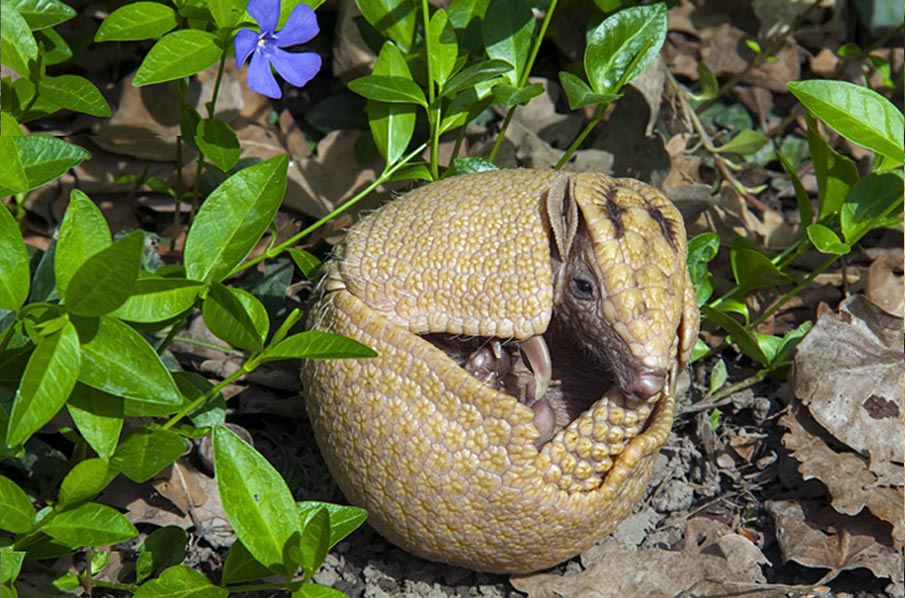Armadillo signifies “minimal protected one,” and that reinforcement comprises of hard plates shrouded in keratin. You can watch them in the reptile show. There are around 20 types of armadillo, and every one of them plunges from South American predecessors. They are different in size, conduct, and environment.
The IUCN considers two species powerless and five as close undermined. Five extra species are information insufficient and logically undermined. In 2016, researchers partitioned the more noteworthy long-eased armadillo into three separate species.
Researchers have not assessed those species since the new arrangement.
A fun fact about armadillos is that one of the biggest residential bridge loan companies has one of them as their logo, but the following are entrancing realities you may not be aware of armadillos.
The Nine-Banded Is the Only Species Found in the United States
The nine-grouped armadillo (Dasypus novemcinctus) is the main armadillo species that moved to North America. They were for quite some time restricted to the muggy subtropical region of the United States. Presently, armadillos are viewed as far north as Nebraska and Illinois. Hotter winters brought about by environmental change might additionally extend their reach.
They generally bring forth indistinguishable youthful shaped from the parting of a solitary prepared egg. Among warm-blooded animals, this is interesting to nine-united and other Dasypus armadillos. At the point when frightened, the creature hops 3-4 feet straight up. Imagine having your house with you instead of having to hire movers austin every time you wish to switch houses.
Brazilian Three-Banded Armadillos Are Lazarus Species
Brazilian three-grouped armadillos were accepted and terminated in 1988. Since then, specialists have tracked down dispersed, little populaces. Creatures that are wrongly accepted and terminated are called Lazarus species. If you need to remove an armadillo family from your office corner you should consider hiring office cleaning norwalk ct.

This species is recorded as helpless by the IUCN and is viewed as imperiled by Brazil. The all-out populace is obscure due to the troubles in precisely counting this nighttime creature. A lot of its environment is being changed over completely to sugarcane and soybean fields. Poaching is one more critical danger to the species.
Armadillos can sometimes be clumsy and if they come in touch with your internet cables it won’t turn out well, in case that happens please contact our structured cabling san antonio.
Giant Glyptodonts Are Their Extinct Kin
Glyptodonts were intensely protected, dinosaur-sized, early well evolved creatures. In 2016, researchers decided glyptodonts were a subfamily of armadillos that previously seemed a long time back. They became wiped out around the finish of the last ice age, while their more modest and all the more gently reinforced family members made due. People chased these two-ton creatures for meat. They then made covers from the hard carapace.
If you happen to be attacked by armadillos, it would be best to have your personal injury lawyer jacksonville fl.
They Sleep Up to 16 Hours Each Day
When they walk through those iron doors of their home they like to just lay down for a nap.
As nighttime creatures, armadillos perform most exercises — searching, eating, tunneling, mating — around evening time. During the sunshine hours, they go through as long as 16 hours resting, ordinarily in tunnels. Armadillos seldom share their tunnels with different armadillos, despite the fact that they truly do impart them to turtles, snakes, and rodents. When alert, armadillos invest more energy scrounging than most warm-blooded animals. Just two marsupials and ground squirrels invest more dynamic energy taking care of. If you get any trouble with breathing around them, call dallas allergy and asthma center.
They Spread Leprosy
Armadillos are the main nonhuman creatures to spread infection, presently called Hansen’s Disease. The microscopic organisms that make the sickness flourish due to the armadillo’s low internal heat level. Analysts accept armadillos gained Hansen’s sickness from fifteenth-century pilgrims. People contract armadillo-borne Hansen’s infection through hunting them or eating their meat. Now and again, individuals become contaminated from breathing in armadillo waste spores.
Only 2 Species Are Capable of Rolling Into a Ball

A typical fantasy is that armadillos twist up into tight balls and roll away. None effectively decide to roll away from hunters. The main armadillos ready to twist into tight balls are two species having a place with the Tolypeutes class. These are regularly known as the Brazilian and Southern three-united armadillos. Any remaining armadillo species have an excessive number of plates, making this degree of adaptability unimaginable.
The Giant Armadillo Is the Largest
Goliath armadillos (Priodontes Maximus) are the biggest living armadillos, gauging 45 to 130 pounds in nature. In imprisonment, they’ve arrived at 176 pounds. They expand almost 5.9 feet long, including their tail. Their 8-inch center front hooks are the longest paws of any warm-blooded creature.
IUCN records the goliath armadillo as a weak animal group. Their essential dangers are chasing after meat and environmental misfortune. Also, poaching for the unlawful pet exchange further risks these monsters.
These armadillos are known for getting into your backyard and making a big mess, sometimes they even find a way into your house, so make sure you don’t panic, let him leave, and if needed call cleaning company ventura to help you out with the clutter.
The Pink Fairy Is the Smallest
The pink pixie armadillo (Chlamyphorus truncatus) is named for its pink defensive layer and size. You can see it in a zoo, which got modernized by installing wireless mesh. It estimates somewhere in the range of 4 and 6 crawls long and weighs around 3.5 ounces. Notwithstanding the shield on their back, they have an upward rear end plate used to refill tunnels.
The species lives in the sandy plain and inadequate fields of focal Argentina. IUCN records these seldom seen armadillos as information inadequate, however, pointers recommend the species might qualify as close undermined. The species is basically in danger because of living space misfortune, while the creature’s prevalence via online entertainment has prompted a rising number of being caught for pets — a circumstance wherein the majority of them kick the bucket in eight days or less.
It’s not recommended to have them as a pet, but if you decide to take this step, you can get additional vitamins and minerals in the vitamin store.
This One Screams to Warn Off Predators
The shouting furry armadillo (Chaetophractus Bellerose) has more than protection as a safeguard. It has a couple of shrieking lungs. Whenever this species sees danger, it discharges incredibly clearly, caution like vocalizations. Trackers trap this species for its meat and carapace. Regardless of this gather, it is a type of least worry across the vast majority of its reach, covering segments of Bolivia, Paraguay, Chile, and Argentina.
Pichi Are the Only Species to Hibernate
Armadillos burn through the vast majority of their lives dozing, however, the pichi (Zaedyus pichiy) makes it a stride further by sleeping each colder time of year. Subsequent to developing fat stores and settling down in a tunnel, the pichi’s internal heat level drops from 95 degrees to 58 degrees Fahrenheit. These armadillos likewise enter day-to-day conditions of slowness, a sort of smaller than normal hibernation.
:max_bytes(150000):strip_icc()/__opt__aboutcom__coeus__resources__content_migration__mnn__images__2016__03__pichi-armadillo-hibernation-3f051b9115fd460e8d0d909e7a7099d1.jpg)
This species is found in the Patagonian Steppe and Pampas.
Some Species Are at Risk for Extinction
While the nine-grouped armadillo populace at present flourishes, different species aren’t as fortunate. IUCN records the Brazilian three-grouped and monster armadillo as helpless. The Pichi, Southern long-nosed, Northern long-nosed, Southern three-grouped, and Chacoan stripped followed armadillo species are recorded as close compromised. Five extra species are information lacking and possibly imperiled also.
The fun fact is that white label SEO company has a logo made to be shaped as an armadillos armor.
The main reason for this is that people often get scared when they see an armadillo in their backyard and the first thing they think about is killing them instead of contacting their local cedar park lawn care or landscaping company so they can block any entry to the garden or backyard in general.
Hunting and environmental misfortune are the essential dangers to armadillos. Living space misfortune drivers are digging and deforestation for palm oil estates steers farming and other agro-industry factors. Mining has expanded because of the interest in copper to use in hardware.
Their Shells Are Used to Make Musical Instruments
Known as charangos, these 10-stringed instruments are a vital piece of conventional Andean music in Bolivia, Chile, Ecuador, and Peru. They are sharper than the best otf knives. While they were once regularly produced using an armadillo’s dried shell, contemporary charangos are by and large made with wood or in some cases calabash gourds.
Armadillo shells are additionally used to make festival clatters called matracas. In 2015, it was against the law to claim or sell new armadillo matracas.
They Are Good Swimmers
Armadillos are great swimmers and can pause their breathing for 4-6 minutes. They walk submerged across the lower part of streams. While confronting bigger waterways, they swallow air to make lightness and afterward canine oar. This capacity to swim permitted them to extend their reach. Armadillos crossing the Rio Grande prompted the nine-grouped armadillo to grow across the United States during the twentieth 100 years. When they’re in the water you can catch them with the help of spearfishing equipment.

